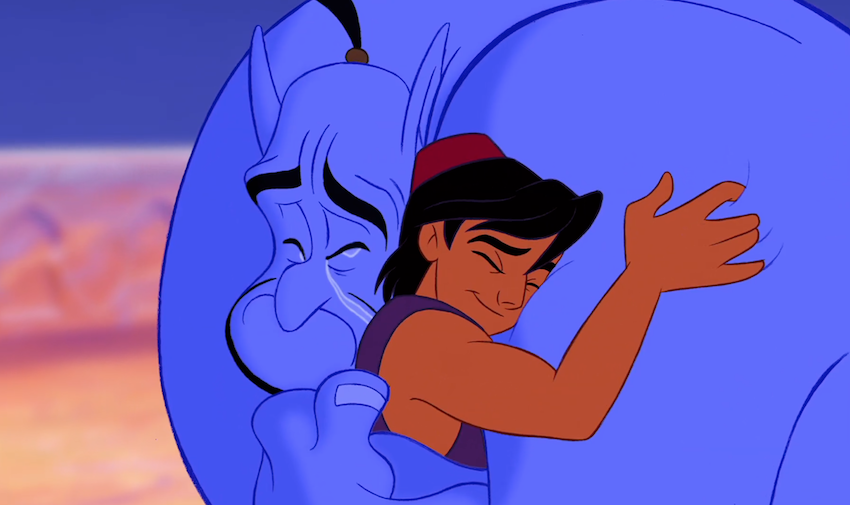 Credit: Disney
Credit: Disney
Genie, You're Free
Robin Williams, Mental Health, and the Stories We Tell About Suicide
By Kai Cheng Thom
Content Warning: Discussion of suicide
“Make no mistake about people who leap from burning windows […] It’s not desiring the fall; it’s terror of the flames. And yet nobody down on the sidewalk, looking up and yelling ‘Don’t!’ and ‘Hang on!’ can understand the jump. Not really. You’d have to have personally been trapped and felt flames to really understand a terror way beyond falling.” - David Foster Wallace, ‘Infinite Jest’
It is a desperate kind of arrogance that leads us to presume to know and judge the reasoning of individuals who have ended their lives. This same desperate arrogance allows for the social illusion that the world we live in is a fundamentally just and orderly place, that the advances of Western science and industry are the solution to virtually any problem, and that everything is under control. By this logic, we are able to minimize the depth of the effect that suicide has on our individual and collective psyches; to label, diagnose, and thus control the flood of emotions that suicide leaves in its wake.
It is little wonder, then, that when Robin Williams’ death came to light about a month ago, local and national media networks exploded with all manner of opinion, conjecture, and debate about Williams’ much-publicized struggles with mental health. Simultaneously, millions of individuals took to Facebook, Twitter, and other online platforms to post the numbers of suicide hotlines, and to blog and reblog articles about mental health while mourning the celebrated actor-comedian.
Indeed, the level and tone of social media response to Williams’ passing reached such fever pitch that some commentators and mental health experts worried about the possibility of “copycat” suicides. This was particularly in response to a tweet posted by the Academy of Motion Picture Arts and Sciences featuring a still from the Disney film Aladdin with the caption “Genie, you’re free” (a reference to Williams’ iconic role as the Genie in the Lamp). Most of this, of course, was well intentioned.
However, sifting through the outpouring of articles, Facebook statuses, tweets, and comments that inundated my news feeds, I was struck by a feeling of profound discomfort and confusion: the point of all this public discussion on “mental health” is, ostensibly, to mourn and honour one of the most brilliant performing artists of our time, and yet the man himself has disappeared. Where has he gone? His voice has been subsumed by the roar of an audience that even now continues to consume him. Like the wishes of the Genie, the meaning of his final choice has been obscured by another, greater, agenda: to contain the “suicide contagion,” to spread the message that suicide is an illness that can be quarantined, constrained, controlled.
To believe some of the media pieces that have most powerfully seized hold of the public imagination, it is not Williams, but the public who is to decide on the reason for, meaning, and legacy of his death – as with so many public figures before him. One particularly viral article boldly states that “Robin Williams didn’t die from suicide [but rather from] depression.” A writer for Psychology Today pronounced him “a functional and productive member of society who chose to commit suicide because of an irrational belief system that convinced him there was no other way to persevere through his emotional anguish.” (What relevance Williams’ “productivity” in society has to any part of this discourse is unclear.) Thus, Williams is reduced to a passive victim of mental illness, a psychological statistic (albeit famous), an “irrational belief system,” a two-line armchair diagnosis. Yet, the Robin Williams that a whole generation loved was anything but passive – he was a ball of lightning, a crackling, cackling, devilish laugh, a shape-shifting trickster, a ferocious wit. Why, then, have so many of us chosen to tell a different story of who he was now that he is gone? And why is that story so tempting?
It comes down, perhaps, to the tension between what is easy to believe, and the complexity of the reality of suicide. It is so much easier, so much less troubling, to remove the element of rational choice from the matter – to say, as I once learned in a suicide prevention workshop, that “no one ever really chooses to die.” In this way, we may avoid asking the terrifying question of why someone we love might choose to leave us. We can turn away from the possibility that, for some us, such a choice is less unthinkable than we would like to pretend. But the consequence of this willful disbelief is the shaming and infantilization of those who are grappling with their reasons for living versus dying. The intersection of choice and suffering is complex terrain, and the reductionist claim that no one ever chooses to die is also implies that it’s crazy to want to – that no one “in their right mind” would ever want to stop living. This creates a paradigm in which there are “normal” (non-suicidal) people and “abnormal” (mentally ill) people, with the latter needing to be “cured” and thereby restored to normality. Thus, the “died of depression” or “died as a result of irrational beliefs” perspective on suicide reinforces stigma even while trying to dispel it.
Yet the truth is that most, if not all, people think about suicide, and, in my experience as a community worker, usually for many very real reasons that are inextricably linked to individual contexts. That is to say: only Robin Williams will ever know why he died. We commit a violence against his memory in making our own interpretations, in abusing the fact that the dead do not speak for themselves. He was the only expert in his own experience, as we are all in ours, and no one else has the right to claim knowledge of his motivations, his emotions, his capacity for logic. Certainly, it is well known that he struggled with substance dependence and depression in his life – but how are we to know if these struggles were or were not connected to interpersonal relationships, experiences of trauma, or any other life experience? To simply leap over all of that complicated, messy humanity, is to do grave injustice to a man we claim to mourn and respect.
It is so tempting indeed to subscribe to a model that sees depression as an illness inside the individual that can always be cured by therapy and medication – because then, if only we had ‘‘gotten to Robin Williams in time,’’ if only he had spoken out about his experience, if only he had been receiving mental health care, then he would not have died. And indeed, this may be true in a certain sense. People – all people – do need mental health care of some kind. Many people need psychopharmaceuticals, therapy, and many other types of medical attention. But it is also true that Robin Williams had gone to therapy in his lifetime, he did speak out – sometimes publicly – about his struggles with addiction and depression. He was a man of means, with access to medical resources; he was much loved, and still made the choice he did.
We need to ask ourselves, how does naming depression as a physical ailment, absolve us a society of culpability for suicide? How does immediately leaping into a medicalized dialogue around individual mental health allow us to avoid discussing the fact that we have created social environments that make us suicidal? Suicide is always a tragedy, but it also often a message, a message that points to injustice and suffering in the world that has everything to do with the way we treat each other. When we look at anyone’s suicide and say, ‘‘that happened because of a mental illness, this person died of illness,’’ we are also saying that said person did not die of abuse, of neglect, of isolation, of horrifying individual circumstance, of social oppression, of the fact that just living in this place and time is very often an incredibly difficult thing.
So let us continue to tell stories about suicide – but instead of seizing the stories of others and imposing an preconceived understanding upon them, let us listen to the complexity, the tension, the horrible human messiness that come with them. Let’s listen to it all, and accept that we can never fully understand the force that drive us to live and die. Let us honour and respect the choices of those struggling and those who are now beyond struggle – even if those choices took them from us. And let us keep on working, listening, loving, laughing – laughing and loving above all – in the hope that someday no one ever need make those choices again.
Kai Cheng Thom
Kai Cheng Thom is a writer and community worker currently completing a Master’s degree in clinical social work. They are also the co-founder of Monster Academy, a community mental health project for youth in Montreal.

